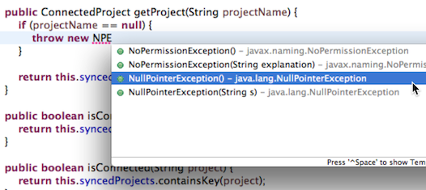 |
Spring XD 1.1 GA goes big on streaming data
|
Spring XD addresses numerous IoT, Analytics, Batch Workflow, and CEP challenges within a unified platform – just to name a few. Whether through continuous data streams with Spark, Python, RxJava or Reactor, or schedule-based data movements, Spring XD provides end-to-end data pipeline capabilities to consume, process, analyze, and stage data where and how you need it. It offers thousands of combinations of data pipelines that can be built out of the box, with no coding required – but if you want to code and extend Spring XD, you can use proven extension points like Spring Integration channel adapters. Unlike other stream processing frameworks, this feature is backed by the enterprise-trusted Spring Integration project, which is recognized as the market share leader. If you’ve ever felt the pain of learning too many Hadoop projects, each with a different programming and configuration model, this is the solution for you. Best of all, it works with all the major Hadoop distributions – Apache, Cloudera and Hortonworks.
|
Monthly Expert Tech-Tips
By Josh Long and Martin Lippert
|
Spring XD 1.1’s Stream Processing
This tip is drawn heavily from this Wiki-page on Spring XD's streaming support by various Spring XD team-members, and particularly the amazing Ilayaperumal Gopinathan Spring XD 1.1 is packed with lots of new features. One theme for this release is rich stream processing support. Spring XD 1.1 provides integration with Project Reactor Streams, RxJava Observables, and Spark's streaming. Let's look specifically at using Reactor, though the concepts are similar across all of the supported streaming APIs. Messages that are delivered on the Message Bus are accessed from the input Stream. The return value is the output Stream that is the result of applying various operations to the input stream. The content of the output Stream is sent to the message bus for consumption by other processors or sinks. Ready for the code sample and tech tip details? Click here to view the rest of the article on the Spring blog.
|
Camel case support in code completion
Code completion support in Eclipse and the Spring Tool Suite is aware of the camel case shortcuts. You don’t need to write NullPointerException, for example. It is enough to type in NPE and hit code completion to let it propose the right class name. This also works with lower case characters in between, so typing on “NuPoiEx” will also trigger the code completion to propose NullPointerException as class name. 
|
Webinars
|
Introducing Spring Session
|
Speaker: Josh Long
Back in the era of the application server, HTTP Session replication was a common way to scale out user session data, as well as make it fault tolerant. In today's world of lightweight containers, PaaS, and virtualization, Spring session offers a 100% server and/or container portable HTTP Session. Spring Session easily plugs in implementations like Redis, scales out across a cluster, handles multiple users' browser sessions, works with WebSocket, and allows header based authentication within REST apps. It's a perfect fit for working with user data, particularly in a highly distributed environment like the cloud, or on a Platform like Cloud Foundry.
|
Europe
Tuesday, February 24, 2015
3:00PM GMT Time
(London, GMT)
|
North America
Tuesday, February 24, 2015
10:00AM PST
(San Francisco, GMT-08:00)
|
|
|
A Single-Page Application with Spring Security and Angular JS
|
Speaker: David Syer
Spring Security, Spring Boot and Angular JS all have nice features for making it really easy to produce modern applications, so there is potentially a lot of value in making them work together very smoothly. Things to consider are cookies, headers, native clients, various security vulnerabilities and how modern browser technology can help us to avoid them.
In this session we show how nice features of the component frameworks can be integrated simply to provide a pleasant and secure user experience. We start with a very basic single-server implementation and scale it up in stages, splitting out backend resources and authentication to separate services. The final state includes a simple API Gateway on the front end implemented declaratively using Spring Cloud, and using this we are able to neatly sidestep a lot of the problems people encounter securing a javascript front end with a distributed back end.
|
Europe
Tuesday, March 10, 2015
2:00PM GMT Time
(London, GMT)
|
North America
Tuesday, March 10, 2015
10:00AM PDT
(San Francisco, GMT-07:00)
|
|
|
JHipster for Spring Boot
|
Speaker: Julien Dubois
JHipster focuses on generating a high quality application with a Java back-end using an extensive set of Spring technologies; Spring Boot, Spring Security, Spring Data, Spring MVC (providing a framework for websockets, REST and MVC), etc. an Angular.js front-end and a suite of pre-configured development tools like Yeoman, Maven, Gradle, Grunt, Gulp.js and Bower. JHipster creates a fully configured Spring Boot application with a set of pre-defined screens for user management, monitoring, and logging. The generated Spring Boot application is specifically tailored to make working with Angular.js a smoother experience.
Join Julien for a quick-live coding session to build a simple application, and deploy it to Cloud Foundry.
|
Europe
Tuesday, March 17, 2015
2:00PM GMT Time
(London, GMT)
|
North America
Tuesday, March 17, 2015
10:00AM PDT
(San Francisco, GMT-07:00)
|
|
|
Building a secure Polymer app with Spring backend
|
Speaker: Scott Deeg
Polymer is the latest web framework out of Google. Designed completely around the emerging Web Components standards, it has the lofty goal of making it easy to build apps based on these low level primitives. Along with Polymer comes a new set of Elements (buttons, dialog boxes and such) based on the ideas of "Material Design". These technologies together make it easy to build responsive, componentized "Single Page" web applications that work for browsers on PCs or mobile devices. But what about the backend, and how do we make these apps secure?
In this talk Scott Deeg will take you through an introduction to Polmyer and its related technologies, and then through the build out of a full blown cloud based app with a secure, RESTful backend based on Spring REST, Spring Cloud, and Spring Security and using Thymeleaf for backend rendering jobs. At the end he will show the principles applied in a tool he's currently building. The talk will be mainly code walk through and demo, and assumes familiarity with Java/Spring and JavaScript.
Other Events:
Thursday, February 26th Speaker: Roman Shaposhnik Meetup: Introduction to Hadoop Security Pivotal Office in San Francisco, CA Register here: bit.ly/POSH0063
Monday, March 16th Speaker: Matt Stine Deep Dive Training: Learn about Cloud Native Application Architecture with Spring and Cloud Foundry. Join Matt Stine for this $2,500.00 workshop deep dive at the O'Reilly Software Architecture Conference in Boston, MA. Schedule & Details Tuesday, March 17th Speaker: Scott Deeg Meetup: Building a secure Polymer app with Spring backend Pivotal Office in Palo Alto, CA Register here: bit.ly/POSH0065
|
Europe
Tuesday, March 24, 2015
2:00PM GMT Time
(London, GMT)
|
North America
Tuesday, March 24, 2015
10:00AM PDT
(San Francisco, GMT-07:00)
|
|
|
Spring Guides
|
 |
Creating a stream of live twitter data using Spring XD
You’ll set up Spring XD (eXtreme Data), create a stream to monitor a live twitter feed, and pipe it into a file. You’ll need about 15 minutes and JDK 1.7 or later. If you are on a Mac there are some simple instructions to Install Homebrew. If you don’t have a Mac or you aren’t interested in installing Homebrew, then you can skip that and jump right to Installing Spring XD. |
|
|
|
Whatever you’re building - these 15-30 minute guides are designed to get you productive as quickly as possible , using the latest Spring project releases and techniques as recommended by the Spring team.
http://spring.io/guides
If you want to make contributions to an existing guide, there is a set of guidelines you can read. They include instructions on installing Asciidoctor as well as rendering the content to check out your edits. Just sign our contributor’s agreement and submit a pull request. |
|
댓글 없음:
댓글 쓰기